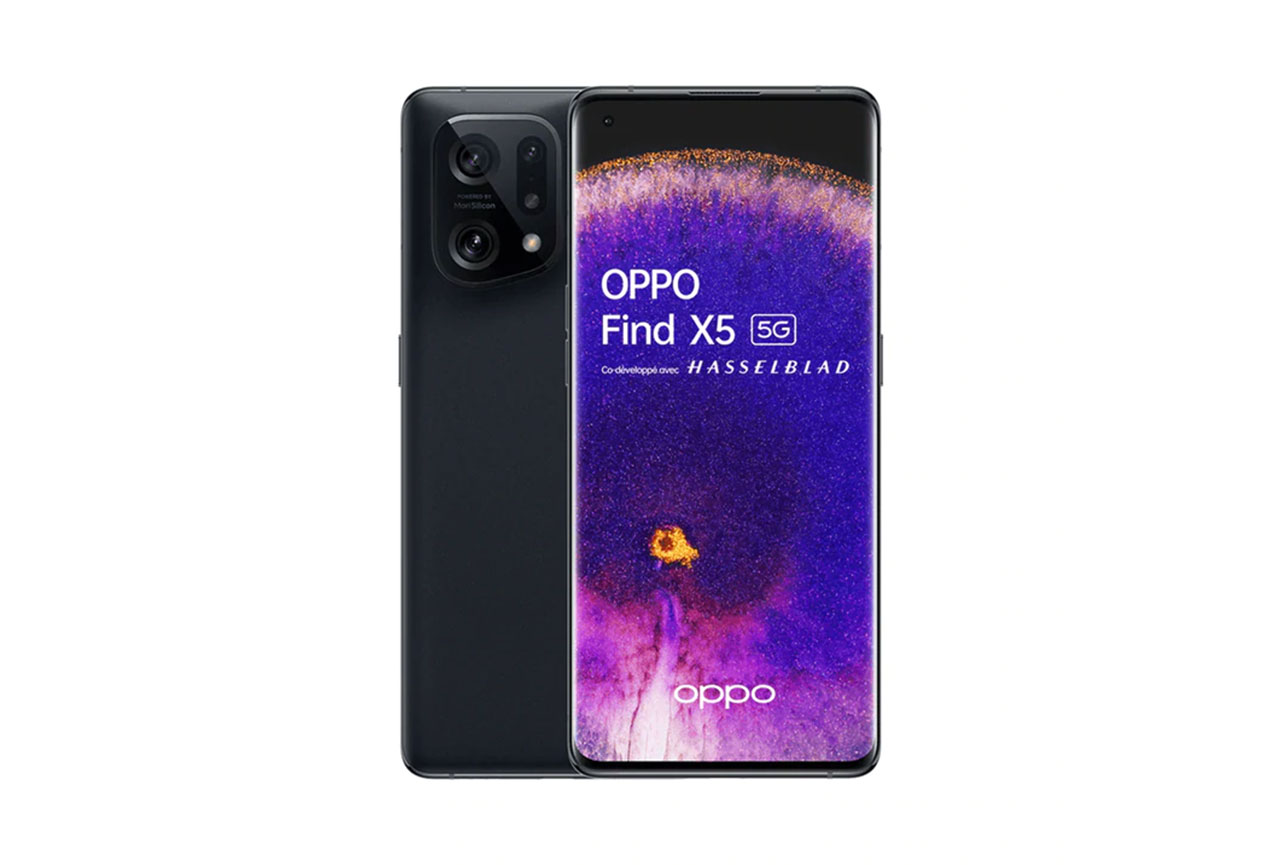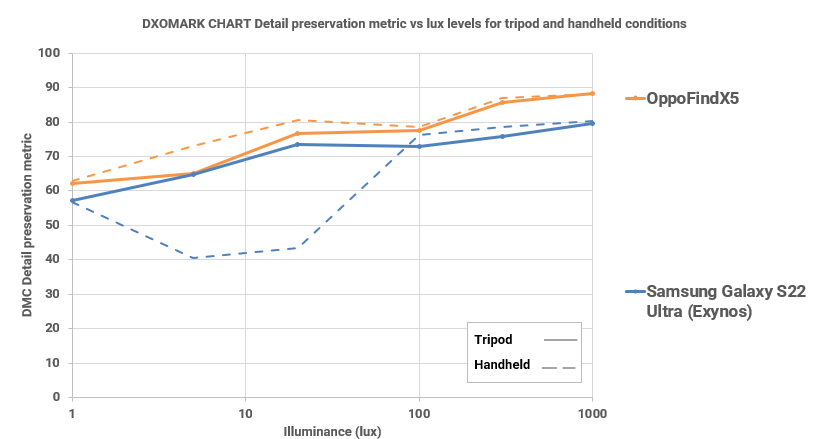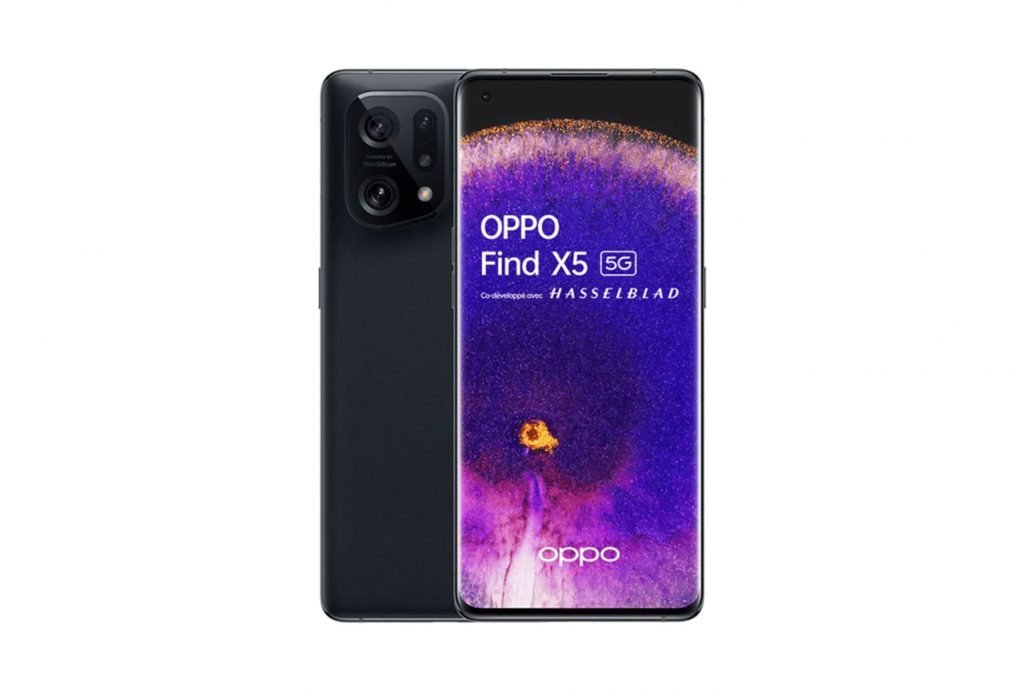The Oppo Find X5 is the slightly less feature-packed (and more affordable) alternative to the Pro model in Oppo’s X5 Ultra-Premium line. It swaps the Pro’s Snapdragon 8 Gen 1 chipset for the slightly older Snapdragon 888 and comes with a slightly smaller and lower-resolution display, but the camera hardware and specs look very similar to the top-of-the-line model’s.
Like for the X5 Pro, Swedish camera makers Hasselblad have contributed to the development and a Marisilicon X neural processing unit helps with image processing. Both primary and ultra-wide cameras feature 50MP 1/1.56″ image sensors, while the 13MP tele unit uses a smaller 1/3.4″ sensor. In video mode, you can record footage with up to 60 frames per second at 4K resolution.
Let’s see how the Oppo Find X5 did in our DXOMARK Camera test.
Key camera specifications:
- Primary: 50MP, 84°field of view, f/1.8-aperture lens, OIS, AF
- Ultra-wide: 50MP sensor, 110°field of view, f/2.2-aperture lens, AF
- Tele: 13MP sensor, 45°field of view, AF
- 4K at 30/60fps, 1080p at 30/60fps (4K/30fps tested)
About DXOMARK Camera tests: For scoring and analysis in our smartphone camera reviews, DXOMARK engineers capture and evaluate over 3000 test images and more than 2.5 hours of video both in controlled lab environments and in natural indoor and outdoor scenes, using the camera’s default settings. This article is designed to highlight the most important results of our testing. For more information about the DXOMARK Camera test protocol, click here. More details on how we score smartphone cameras are available here.
Test summary
Scoring
Sub-scores and attributes included in the calculations of the global score.
 Oppo Find X5
Oppo Find X5

114
camera
102
Huawei Pura 70 Ultra
Best: Huawei Pura 70 Ultra (130)
111
Apple iPhone 16 Pro
Best: Apple iPhone 16 Pro (130)
84
Huawei Pura 70 Ultra
Best: Huawei Pura 70 Ultra (125)
114
Xiaomi 15 Ultra
Best: Xiaomi 15 Ultra (125)
85
Huawei Pura 70 Ultra
Best: Huawei Pura 70 Ultra (117)
68
Xiaomi Redmi 12 5G
Best: Xiaomi Redmi 12 5G (82)
60
Huawei Pura 70 Ultra
Best: Huawei Pura 70 Ultra (85)
60
Apple iPhone 16 Pro
Best: Apple iPhone 16 Pro (93)
64
Xiaomi 15 Ultra
Best: Xiaomi 15 Ultra (128)
103
Huawei Pura 70 Ultra
Best: Huawei Pura 70 Ultra (122)
72
Oppo Find X8 Pro
Best: Oppo Find X8 Pro (116)
81
Oppo Find X8 Pro
Best: Oppo Find X8 Pro (120)
79
Huawei Pura 70 Ultra
Best: Huawei Pura 70 Ultra (120)
104
Oppo Find X6 Pro
Best: Oppo Find X6 Pro (118)
100
Apple iPhone 16 Pro
Best: Apple iPhone 16 Pro (120)
72
Xiaomi 12S Ultra
Best: Xiaomi 12S Ultra (86)
94
Apple iPhone 16 Pro
Best: Apple iPhone 16 Pro (119)
Use cases & Conditions
Use case scores indicate the product performance in specific situations. They are not included in the overall score calculations.
Outdoor
Photos & videos shot in bright light conditions (≥1000 lux)
Indoor
Photos & videos shot in good lighting conditions (≥100lux)
Lowlight
Photos & videos shot in low lighting conditions (<100 lux)
Friends & Family
Portrait and group photo & videos
Please be aware that beyond this point, we have not modified the initial test results. While data and products remain fully comparable, you might encounter mentions and references to the previous scores.
Position in Global Ranking

128
th
4. Apple iPhone 16 Pro Max
157
10. Apple iPhone 15 Pro Max
154
22. Honor Magic4 Ultimate
147
26. Apple iPhone 14 Pro Max
146
26. Motorola Edge 50 Ultra
146
26. Samsung Galaxy S25 Ultra
146
32. Samsung Galaxy S24 Ultra
144
34. Apple iPhone 13 Pro Max
141
34. Google Pixel 9 Pro Fold
141
38. Samsung Galaxy S23 Ultra
140
43. Tecno Camon 40 Pro 5G
138
45. Vivo X80 Pro (Snapdragon)
137
52. Samsung Galaxy S22 Ultra (Snapdragon)
135
52. Vivo X80 Pro (MediaTek)
135
59. Samsung Galaxy Z Fold6
133
59. Samsung Galaxy S24+ (Exynos)
133
59. Samsung Galaxy S24 FE
133
59. Samsung Galaxy S24 (Exynos)
133
69. Samsung Galaxy Z Flip6
132
70. Apple iPhone 12 Pro Max
131
70. Samsung Galaxy S22 Ultra (Exynos)
131
81. Samsung Galaxy Z Fold5
128
83. Asus Smartphone for Snapdragon Insiders
127
83. Samsung Galaxy Z Flip5
127
83. Samsung Galaxy S23 FE
127
88. Vivo X70 Pro (MediaTek)
126
92. Asus Zenfone 11 Ultra
125
92. Samsung Galaxy S22+ (Exynos)
125
97. Samsung Galaxy Z Fold4
124
100. Apple iPhone 11 Pro Max
122
105. Xiaomi Redmi Note 13 Pro Plus 5G
121
106. Samsung Galaxy Z Fold3 5G
120
106. Samsung Galaxy S22 (Exynos)
120
106. Xiaomi Redmi Note 13 Pro 5G
120
111. Xiaomi Redmi Note 14 Pro+ 5G
118
114. Apple iPhone 12 mini
117
114. Samsung Galaxy S21 Ultra 5G (Snapdragon)
117
114. Samsung Galaxy S21 FE 5G (Snapdragon)
117
114. Samsung Galaxy S21 5G (Snapdragon)
117
120. Vivo X60 Pro 5G (Snapdragon)
116
123. Motorola Edge 50 Neo
115
123. Samsung Galaxy S21+ 5G (Snapdragon)
115
123. Samsung Galaxy S21 Ultra 5G (Exynos)
115
133. Crosscall Stellar-X5
113
133. Xiaomi Redmi Note 12 Pro+ 5G
113
137. Samsung Galaxy Z Flip4
112
139. Samsung Galaxy Z Flip3 5G
111
139. Samsung Galaxy S21+ 5G (Exynos)
111
139. Samsung Galaxy S21 5G (Exynos)
111
144. Samsung Galaxy A55 5G
108
144. Vivo X60 Pro 5G (Exynos)
108
149. Samsung Galaxy A54 5G
107
150. Xiaomi Redmi Note 14 Pro 5G
106
153. Samsung Galaxy A35 5G
104
154. Motorola Edge 40 Neo
103
154. Xiaomi Redmi Note 14 5G
103
156. Xiaomi Redmi Note 12 Pro 5G
102
158. Motorola Edge 30 Pro
101
160. Apple iPhone SE (2022)
100
162. Motorola Moto g75 5G
96
168. Samsung Galaxy A34 5G
92
168. Samsung Galaxy A25 5G
92
172. Xiaomi Redmi Note 13 5G
91
174. Motorola Moto g85 5G
88
174. Samsung Galaxy A52s 5G
88
174. Samsung Galaxy A52 5G
88
178. Motorola moto g54 5G
85
178. Samsung Galaxy A33 5G
85
178. Samsung Galaxy A16 LTE
85
181. Honor Magic6 Lite (5300 mAh)
84
181. Xiaomi Redmi Note 14
84
184. Samsung Galaxy A15 5G
83
186. Samsung Galaxy A15 LTE
81
187. Samsung Galaxy A53 5G
79
189. Xiaomi Redmi Note 11 Pro 5G
78
191. Samsung Galaxy A16 5G
77
193. Motorola Moto G35 5G
75
193. Xiaomi Redmi Note 13
75
196. Honor Magic5 Lite 5G
74
198. Samsung Galaxy A23 5G
70
199. Xiaomi Redmi Note 12 5G
69
202. Motorola moto g34 5G
67
202. Samsung Galaxy A14 5G
67
204. Motorola Moto G62 5G
66
205. Xiaomi Redmi Note 11S 5G
65
207. Xiaomi Redmi Note 12
63
212. Honor Magic4 Lite 5G
61
214. Xiaomi Redmi Note 11
60
216. Crosscall Stellar-M6
59
223. Xiaomi Redmi 10 2022
51
225. Samsung Galaxy A22 5G
48
Position in Ultra-Premium Ranking

85
th
4. Apple iPhone 16 Pro Max
157
10. Apple iPhone 15 Pro Max
154
20. Honor Magic4 Ultimate
147
23. Apple iPhone 14 Pro Max
146
23. Motorola Edge 50 Ultra
146
23. Samsung Galaxy S25 Ultra
146
28. Samsung Galaxy S24 Ultra
144
30. Apple iPhone 13 Pro Max
141
30. Google Pixel 9 Pro Fold
141
34. Samsung Galaxy S23 Ultra
140
38. Vivo X80 Pro (Snapdragon)
137
43. Samsung Galaxy S22 Ultra (Snapdragon)
135
43. Vivo X80 Pro (MediaTek)
135
48. Samsung Galaxy Z Fold6
133
48. Samsung Galaxy S24+ (Exynos)
133
53. Samsung Galaxy Z Flip6
132
54. Apple iPhone 12 Pro Max
131
54. Samsung Galaxy S22 Ultra (Exynos)
131
61. Samsung Galaxy Z Fold5
128
63. Asus Smartphone for Snapdragon Insiders
127
63. Samsung Galaxy Z Flip5
127
68. Asus Zenfone 11 Ultra
125
68. Samsung Galaxy S22+ (Exynos)
125
71. Samsung Galaxy Z Fold4
124
73. Apple iPhone 11 Pro Max
122
76. Samsung Galaxy Z Fold3 5G
120
81. Samsung Galaxy S21 Ultra 5G (Snapdragon)
117
83. Samsung Galaxy S21+ 5G (Snapdragon)
115
83. Samsung Galaxy S21 Ultra 5G (Exynos)
115
89. Samsung Galaxy Z Flip4
112
90. Samsung Galaxy Z Flip3 5G
111
90. Samsung Galaxy S21+ 5G (Exynos)
111
Pros
- Good exposure and wide dynamic range
- Good texture and detail
- Smooth zooming in preview
- Good detail in bright light and indoor videos
- Good video white balance in bright light video
Cons
- Strong exposure variation
- Focus delays and narrow depth of field
- Color casts, especially in low light
- Noise in bright light and indoors
- Haloing results in unnatural subject rendering
- Focus issues and exposure instabilities in night shots
- Limited dynamic range in video
- Lack of fine detail and unstable autofocus in low light video
With a DXOMARK Camera score of 122, the Oppo Find X5 isn’t quite up there with the very best in the Ultra-Premium segment but delivers an overall decent camera performance.
In low contrast conditions, like in this scene, exposure is good, with fairly neutral white
balance and nice colors. The camera also captures good detail.
In photo mode, the camera produces good exposures and in bright light and indoors a very wide dynamic range ensures good detail in both highlight and shadow areas of the frame. However, in low light, the Oppo has a tendency to slightly underexpose in order to avoid highlight clipping, which often results in some clipping of shadows, and our testers also observed some strong exposure variation between shots. Colors are generally nice, but color casts are often noticeable, especially in low light. The camera captures good detail, but image noise could be better controlled in bright light and under typical indoor conditions.
The camera controls in preview are a plus point. Controls are smooth, making zooming in and out a pleasant affair. Night shots can be slightly problematic insofar as our testers observed focus issues and strong exposure instabilities across consecutive shoots.
Our lab measurements show that the Find X5 records very good detail across all light levels when compared to the Samsung Galaxy S22 Ultra (Exynos).

This graph shows DMC detail preservation against the light level (in lux) for handheld and tripod-mounted shooting.
DMC detail preservation metric is an AI-based texture analysis trained on three selected crops of our
DXOMARK chart. The closer the value is to 100, the higher is detail preservation.
When using the tele, the camera captures nice colors and produces accurate exposures. The level of detail is generally good, even at long zoom factors. However, some loss of detail can be observed at intermediate tele zoom settings, before the Oppo switches from the primary camera to its tele camera module. The 15mm ultra-wide angle does a good job as well, both at its native focal length and when zooming in. When recording a series of shots our testers did observe some instabilities of anamorphosis (perspective distortion close to the edges of the frame), though.
Crop: accurate exposure and nice color, good level of detail
When recording video, the Oppo Find X5 does well in bright light and under indoor conditions. White balance is generally pleasant as well, and like the class leader Apple iPhone 13, the Oppo is capable of smooth exposure transitions in difficult high-contrast scenes. In terms of dynamic range, the Find X5 is less impressive and footage often shows highlight and shadow clipping. Video color is generally nice, except in portrait scenes where skin tones can look too saturated. Noise is an area for improvement. It is quite intrusive in bright light videos and becomes worse as the light gets dimmer. This is also where the autofocus starts to show some instabilities.
In this sample clip, we can witness the Oppo Find X5’s limited dynamic range. Highlight clipping is visible in the bright window. The exposure adapts the wrong way (darker) when the model turns to face camera. Some noise is noticeable but the level of detail is quite high.
Accurate white balance but limited dynamic range and some shadow noise



 128th
128th 85th
85th





DXOMARK encourages its readers to share comments on the articles. To read or post comments, Disqus cookies are required. Change your Cookies Preferences and read more about our Comment Policy.